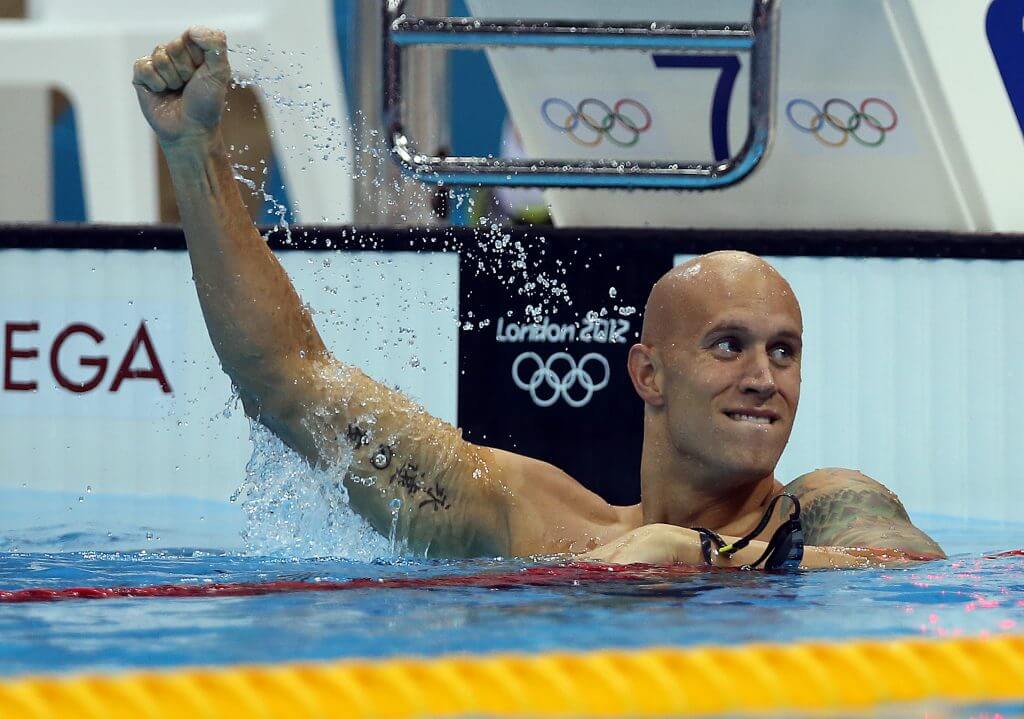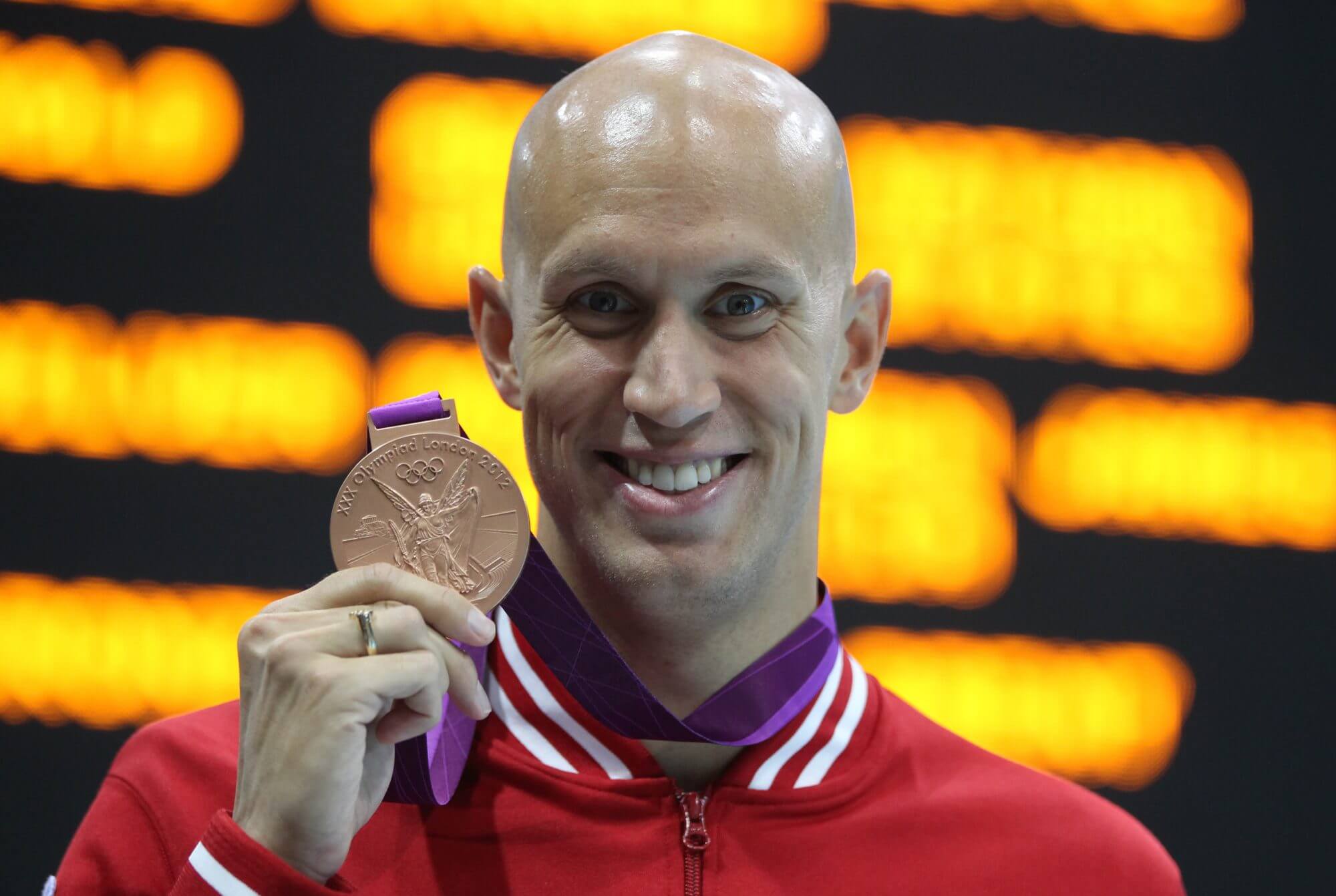For Brent Hayden, Comeback is about Falling in Love with Swimming Again

For Brent Hayden, Comeback is about Falling in Love with Swimming Again
Brent Hayden took in the view from the middle of Sasamat Lake, somewhere that a month earlier, or a year earlier, or five years earlier, he never thought he’d be.
With COVID-19 lockdowns in full effect in British Columbia, Hayden embarked on what became a rite of spring for swimmers in 2020: Looking for a way to stay in shape. First, it was the pool at his parents’ house, the three-time Olympian hooking himself via bungee cord to a fence and using Form Goggles to gauge his pace and distance.
Inevitably, the quest for available water led to … well, open water. Hayden got his hands on a wetsuit and headed for Western Canada’s ample natural waterways with a group of likeminded swimmers, an experience entirely new for the 36-year-old.

Brent Hayden with the bronze medal from the 100 freestyle at the 2012 Olympics. Photo Courtesy: Swimming Canada
Something about the freedom of the lake resonated with Hayden, not just because of the restlessness of lockdowns during the COVID-19 pandemic. Hayden had retired in 2012 after his biggest swimming accomplishment, a bronze medal in the 100 freestyle in London. He walked away with nagging back spasms and a tightening grip of depression. Deep into retirement, when the days of competition had long past, being in the water for anything more intensive than a swim clinic was “emotionally painful.” He could count on two hands the number of times he’d swum more than 200 meters from 2012 to 19, his mind gravitating toward negative memories whenever a session started to feel like training.
But that spring day, in Sasamat Lake, all the reasons why he has mounted a comeback in the pool swirled around him like the lake’s chilly water.
“It’s different when you’re not confined between two walls and two lane ropes,” Hayden told Swimming World last week. “You’re in the middle of the lake and you’re like, ‘I could just swim anywhere I want. Maybe I’ll go to that point or to this bridge over there.’ It was kind of liberating in a way. I’m really glad that I got the opportunity to experience that.”
The freedom Hayden has found in his comeback swells from his renewed joy in the water. He’s confident that he can swim faster at age 37, when the Tokyo Olympics (hopefully) arrive, than he ever has.
“It makes me excited to see what more I can do,” Hayden said. “I believe I have a 21-low in me.”
Back to the water
Brent Hayden’s journey back started in Lebanon.
A five-time World Championships medalist – including the 2007 champ in the 100 free – who’d won gold at Pan Pacs and the Commonwealth Games, Hayden was one of the world’s veteran sprinters before the 2012 Olympics. Olympic glory had eluded him, though, missing the final in both of his previous Games.
In London, he finally broke through. The first Canadian to make the 100 free final since Dick Pound in 1960, Hayden surged from lane 7 to sneak into bronze, .04 seconds ahead of Yannick Angel. With the back pain and depression fears, Hayden declared his retirement before the Closing Ceremonies. Eighteen days after his bronze swim, he was in Lebanon, marrying longtime girlfriend Nadina Zarifeh.
It wasn’t until he spent time with his wife’s family in Zouk Mosbeh in 2019 that the idea of returning to the pool even remotely entered his mind. He still worked out regularly, the routine important to his post-retirement physical and mental health, and still conducted swim clinics for kids.
While in Lebanon, Hayden was looking for a place to record videos of his clinic curriculum. Eventually, he cold-called the Jeita Country Club, and once he’d convinced its owner that the Olympian looking for pool space wasn’t a practical jokester, he was granted free reign.
Something about the setting – Jeita’s spacious pool opening to sprawling vistas of Lebanon’s verdant hills, tiny towns cropping out of the surrounding mountains, the juxtaposition of the radiant sun on deck and the crispness of the water – triggered happy memories Hayden didn’t know he still held.
“I’m not sure if I can accurately explain how it felt,” Hayden said. “It’s kind of like finding something that you thought you lost, that you thought was gone forever.”
Suddenly, Hayden wanted to be in the water, wanted to see how far he could push himself. Gone was the automatic revulsion at the thought of swimming more than 200 meters. Instead, he felt comfortable, in the way an elite athlete so exquisitely in tune with his body can.
The clincher came at a clinic in Beirut, where the kids egged him on to do a 25 off the block. There were no watches on deck. But if felt fast to Hayden. Timing the video footage at just over 10 seconds confirmed it. Just to be safe, he got a second opinion from former sprinter turned coach Brett Hawke. Only then did a comeback plan start to take shape.
Still uncertain, Hayden reached out to sprinting friends, for confirmation and confidence. From Anthony Ervin, who in Rio became the oldest Olympic swimming gold medalist in the 50 free at age 35, he got encouragement and an open invitation to race when he’s in Ontario, where Ervin splits time with his fiancée’s family. From Brazilian Bruno Fratus, Hayden got a more profound message.
“He said he looked up to me when he was up-and-coming,” Hayden said. “That’s a really good feeling when somebody who I’m looking at as a superstar now is like, yeah, I really looked up to you. It’s like, really? That was just super cool.”
And it was proof enough that this was real. Hayden wanted to give it a shot and felt he could swim again at a high level, the twin aspects of the plan. So two days after his 36th birthday last October, he officially called time on a seven-year retirement.
That age-group feeling
Before the world ground to a coronavirus-induced halt, Brent Hayden was doing things that 36-year-olds simply aren’t supposed to: He was setting best times. While training in Hawaii in January, he broke the 20-second barrier in the 50-yard free for the first time, an event and course he’d rarely trained over. In early March, he finished third in the TYR Pro Swim Series stop in Des Moines, behind Caeleb Dressel and Nathan Adrian. The time of 21.97 is the first or second time he’s been sub-22 in a textile suit, against a field that mostly never had the option to swim in bodysuits.
“You kind of feel like when you’re an age-group swimmer and you get under 50 seconds for the first time in the 100 free,” Hayden said. “I think this was the first time I got under 22 without the bodysuit. That’s definitely a milestone for me, and then it just makes me really excited too because I was able to do that off only six months of training off seven years of retirement.”
When news of the Olympic postponement broke in March, Hayden took it in stride. The extra year was more than he bargained for. But he was enjoying the journey, not just singularly focused on the destination. With the required delay in racing after returning to the doping control pool, he would’ve had barely a month of sanctioned racing before Canadian Trials in late March. Instead, if racing returns this fall, he’ll get six months of competition before trials next spring, plus all the extra time this year to get stronger.
“I’m just thinking of how fast I was able to get in six months,” he said. “I’m excited thinking about what I’m going to be able to accomplish in the next year. Even though I’m getting older, I still feel like I’m getting stronger.”
Hayden spent March and April working out at home. He got to his parents’ pool by late April. For the last month, he’s been back in the water under semi-regular conditions at the High Performance Center at the University of British Columbia. He’s been impressed by his training partners, including Carson Olafson, Markus Thormeyer and Richard Funk. Though Yuri Kisil last year moved from the Vancouver HPC to Toronto and Hayden laments the missed chance to work with him, he’s hopeful that they have the foundation of a strong relay for Tokyo in place. Hayden plans on primarily pursuing the 50 with the 100 as an option for relay purposes. He believes his mentorship could help the young talents reach their peaks for a program that was shut out of medals at the Rio Olympics.
Instead of blindly paying the mental and physical costs of chasing a medal, Hayden is back to enjoy the process. There’s something reminiscent to what Michael Phelps sought in his return for the Rio Olympics, a commonality in many swimmers emerging from retirement. Hayden has changed the terms of what he’s getting out of it. As successful as he was in 2012 when things were difficult, he enticed by the notion of how well he can perform at peace.
“If I were to come out of retirement, there’s got to be a reason,” he said. “And I think there’s got to be genuine joy during it. Nobody wants to be forced to come out of retirement. We’ve all experienced our own levels of success, Michael with his X number of medals and me with my one. But even with my one medal and the world championships medals, I don’t feel like I have anything to prove this time around. If I come out of retirement and it completely bombs, I’m ok with that.
“It’s more just falling in love with the sport again and being able to leave the sport in a better place than when I left. Any of the results that I can accomplish along the way are just icing on the cake.”




 #oceanwalker #totalimmersion
#oceanwalker #totalimmersion Been gone for too long.
Been gone for too long.